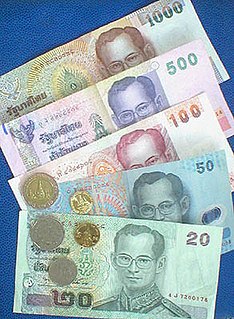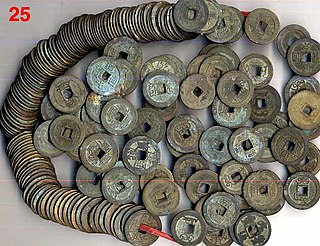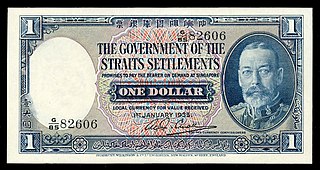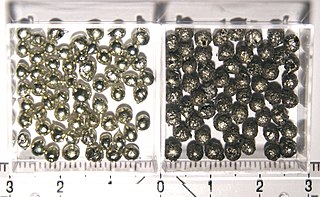
Bronze is an alloy consisting primarily of copper, commonly with about 12–12.5% tin and often with the addition of other metals and sometimes non-metals or metalloids such as arsenic, phosphorus or silicon. These additions produce a range of alloys that may be harder than copper alone, or have other useful properties, such as stiffness, ductility, or machinability.

The tin whistle, also called the penny whistle, flageolet, Irish whistle, Belfast hornpipe, or feadóg stáin, is a simple, six-holed woodwind instrument. It is a type of fipple flute, putting it in the same class as the recorder, Native American flute, and other woodwind instruments that meet such criteria. A tin whistle player is called a whistler. The tin whistle is closely associated with Celtic and Australian folk music.

The baht is the official currency of Thailand. It is subdivided into 100 satang. The issuance of currency is the responsibility of the Bank of Thailand.

The peseta was the currency of Spain between 1868 and 2002. Along with the French franc, it was also a de facto currency used in Andorra.

The Brunei dollar, has been the currency of the Sultanate of Brunei since 1967. It is normally abbreviated with the dollar sign $, or alternatively B$ to distinguish it from other dollar-denominated currencies. It is divided into 100 sen (Malay) or cents (English). The Brunei dollar is issued by the Autoriti Monetari Brunei Darussalam.
The Congolese franc is the currency of the Democratic Republic of the Congo. It is subdivided into 100 centimes.

The Egyptian pound is the currency of Egypt. It is divided into 100 piastres, or ersh, or 1,000 milliemes.

The Belgian franc was the currency of the Kingdom of Belgium from 1832 until 2002 when the Euro was introduced. It was subdivided into 100 subunits, known as centiemen (Dutch), centimes (French) or Centime (German).

The piastre de commerce was the currency of French Indochina between 1885 and 1952. It was subdivided into 100 cent, each of 5 sapèque.
The pitis was a currency of Brunei last issued in 1868 which circulated into the 20th century. It is also referred to as the picil by Antonio Pigafetta and some variants of it were referred to as the kue and the paku. It was later replaced by the Straits dollar in Brunei, which is valued at 4000 pitis or 800 paku and at par with the Spanish dollar.
The pitis was a tin coin issued by several South-East Asian states. It may refer to:

The dollar was the currency of Sarawak from 1858 to 1953. It was subdivided into 100 cents. The dollar remained at par with the Straits dollar and its successor the Malayan dollar, the currency of Malaya and Singapore, from its introduction until both currencies were replaced by the Malaya and British Borneo dollar in 1953.
The dollar was the currency of British colony of Bencoolen on the west coast of the island of Sumatra until the Anglo-Dutch Treaty of 1824, when the British Empire traded away Bencoolen for Malacca.
The keping was the currency of Trengganu until 1909 when it was replaced by the Straits dollar. It was subdivided into 10 pitis. Coins were issued in denominations of 1 pitis (tin), 1 keping (copper) and 10 keping (tin).
The dollar was the currency of Penang between 1786 and 1826. It was subdivided into 100 cents, also called pice, and was equal to the Spanish dollar. The dollar was introduced after the East India Company acquired the island in 1786. In 1826, the Indian rupee was declared legal tender in Penang at a value of 48 pice. The dollar again became the currency of Penang with the introduction of the Straits dollar.

The đồng was the currency of North Vietnam from 3 November 1946 to 2 May 1978. It was subdivided into 10 hào, each itself divided into 10 xu.

Cash was a type of coin of China and East Asia, used from the 4th century BC until the 20th century AD, characterised by their round outer shape and a square center hole. Originally cast during the Warring States period, these coins continued to be used for the entirety of Imperial China as well as under Mongol, and Manchu rule. The last Chinese cash coins were cast in the first year of the Republic of China. Generally most cash coins were made from copper or bronze alloys, with iron, lead, and zinc coins occasionally used less often throughout Chinese history. Rare silver and gold cash coins were also produced. During most of their production, cash coins were cast, but during the late Qing dynasty, machine-struck cash coins began to be made. As the cash coins produced over Chinese history were similar, thousand year old cash coins produced during the Northern Song dynasty continued to circulate as valid currency well into the early twentieth century.

Cash coins were introduced by the Chinese based on their imperial coinage to what is today called Indonesia during the Tang dynasty era in China when they were introduced by traders, but they didn't become popular with the local population until the 13th century during the reign the Majapahit empire in the archipelago. Chinese cash coins continued to circulate in the archipelago for centuries, when the Ming dynasty banned trade with the region many local rulers started creating their own imitations of Chinese cash coins which were often thinner and of inferior quality. Cash coins produced in Indonesia were made from various materials such as copper-alloys, lead, and most commonly tin.

The Palembang pitis was a currency issued by the Palembang Sultanate from the year 1659 under the reign of Sultan Abdulrrahman Khaifatul Mukminin Sayidul Imam until the sultanate was dissolved by the Dutch in 1823 and the territory was fully integrated into the Dutch East Indies.















